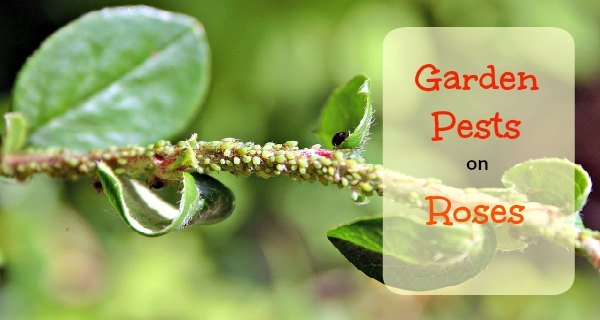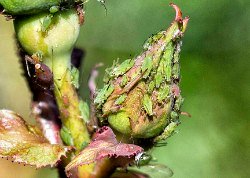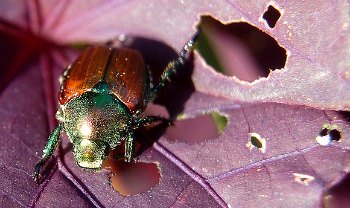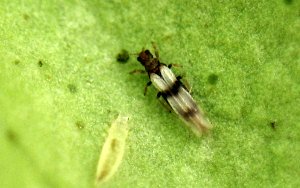Common Garden Pests
It is almost inevitable that garden pests will attack your flowers at some point during the season
Many insects, bugs and other animals will probably love your roses as much as you do. That does not mean that every creepy-crawly that visits your plants is harmful. The best control is vigilance and quick action once you have spotted destructive insects.

I know it is annoying when you want to enjoy your flowers
and finally discover greenfly or spider mites trying to suck out the life of
your flowers.
The first thought might be to kill them instantly with some pesticides, but foremost it is better to
Guide through Pests on Roses

On this page
- How to avoid common rose pests
- Insect Pests and where they colonize - on the stem
- Pests on the leaf
- Pests on flowers
You should also read...
Further Information
- Aphids
- Cane Borers
- Gall Wasp
- Rose stem girdler
- Scales
- Caterpillars
- Leaf cutter bees
- Leafhoppers
- Rose slugs
- Spider mites
- Rose midges
- Japanese Beetles
- Thrips
How To Avoid Common Garden Pests
Some rose varieties are more susceptible to problems than others, but well-fed roses that are growing strongly usually shake off the effects of any attack more readily.
Buying good quality roses will prevent the introduction of pests and diseases into your garden.
Few more practices which help avoid harmful
insects...
- Plant some Beneficial Bug Wildflowers to encourage beneficial insects such as the larvae of ladybugs or lacewings to your garden
- Companion plants like garlic, thyme, rosemary, coriander, fennel, mint or petunias and geranium near your roses will bother several insects
- Build a barrier, a windbreak or plant the roses along a wall or fence. Some pests don’t like barriers and will stay away from the plants
- Catch a problem at an early stage, inspect plants regularly and remove unwanted insects manually or with a jet of water
- Remove larger insects like caterpillars by hand
- Remove smaller insects like aphids with a sharp jet of water (don’t forget the underside of the leaves)
Insect Pests And Where They Colonize
The most common garden pests, what part of the plant they infest and how they look like.
Pests on the Stem

Aphids (Greenfly): Those sap-sucking tiny insects are the most common rose pests and come in many colors like green, black and red.
They damage young shoots and flower buds. Aphids are easy to control.
Cane Borers: When cane growth begins to slow, then wilt and die, it is almost certain that a cane borer is at work.
Read how to deal with cane borers.
Gall Wasp: Mossy green or brown rose galls are created on roses when this insect stings a stem.
There are several different types of galls but most of them are harmless and do no damage.
Rose Stem Girdler: The beetle larvae bore into rose stems of mostly rosa hugonis (Golden Rose of China) and some other species.
They cause the stem to swell and sometimes break. Usually, they do not infest modern roses.
Scale: Scales form a gray or light-brown crust preferable on old stems. Those are the skeletons of the scale.
Simply cut off the stem where that ugly crust sits. If scales are a persistent problem, spray it with lime sulfur or Malathion.
Pests on the Leaf
Caterpillars: Irregular-shaped holes in leaves are the trademarks of the larvae of moths or butterflies.
Although some butterflies may be charming, their larvae on roses are annoying.
Read how to deal with caterpillars.
Leaf Cutter Bees: Unmistakable signs are regular-shaped holes at the sides of leaves. The bee uses the material for its nest.
Because they never ingest the leaves, it does not make sense to spray.
Leafhoppers: Pale mottled patches occur on the upper side of leaves and small, very fast-moving yellowish insects (or their white skin) can be found on the underside.
They may be repelled by
alliums and eaten by assassin bugs. After a severe attack, leaves may fall, and
you have to spray the foliage with Sprayday
Rose Slug: These slug-like worms scrape off the outer tissue of the leaves, leaving skeletonized areas. The veins are not eaten; the leaves turn brown and may fall off.
Pick the slugworms off and dispose of them. If you have a bad attack, spray the leaves with insecticides.
Spider Mites: Very tiny arachnids that barely can be seen. They are on the undersides of the leaves and suck the plant's fluids. The leaves turn yellowish and may show small silvery spots.
A daily sharp jet of water in the morning will help to keep the infestation down.
If the pests are a problem, use a dormant oil spray before roses go to hibernation. This will kill the eggs of the spider mites.
Rose Midges: These garden pest doesn't get along well with alliums and strong-scented herbs. Prune off pest-ridden foliage and flowers as soon as possible.
Pests on Flowers

Japanese Beetles: Beetles like Chafer beetles, June beetles and Cucumber beetles can be a serious problem in some areas. They eat the flowers as well as the leaves, often skeletonize them.
Picking them off can help if they are not too numerous, but if you have serious problems with that bugs, you have to do something.

Thrips: This nearly invisible pest will deform the buds and leave them unopened.






New! Comments
Have your say about what you just read! Leave me a comment in the box below.